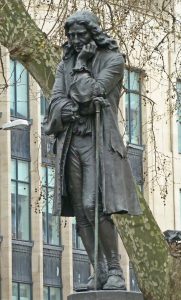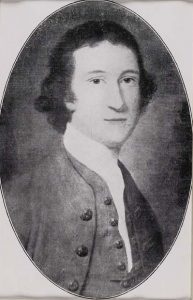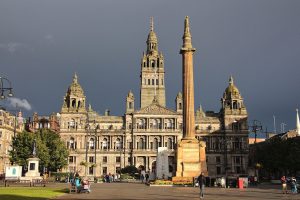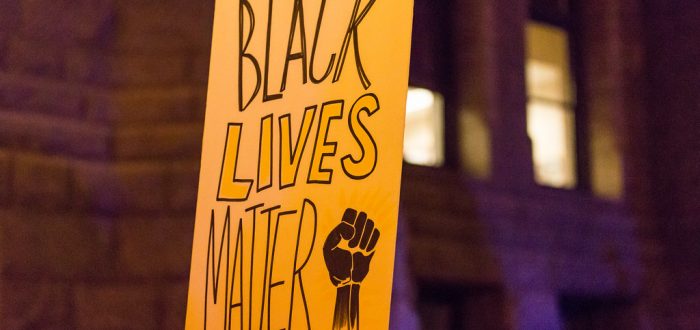Dr Michael Morris explores recent efforts to confront the legacy of Scotland’s involvement in Atlantic slavery, and suggests a possible road-map for public commemoration.
Follow Michael on Twitter at @M_J_Morris81
Following the acquittal of Trayvon Martin’s murderer in 2013, African-American activists developed a new campaign with a name that is poignant in its starkness: Black Lives Matter (BLM). In the wake of the video showing the death of George Floyd under the knee of a police officer in the city of Minneapolis, the latest in a long line of outrages, there has been a surge of support for the BLM movement across the world. International solidarity protests link the global with the local to expand from calls for justice for George Floyd to demand a full reckoning with structural and personal racism in our own respective towns and countries.

The statue of Edward Colston in Bristol, toppled on 7 June 2020.
In Bristol, the statue of the notorious slave trader Edward Colston was pulled down and ended up beneath the waves in the harbour. David Olusoga notes:
The historical symmetry of this moment is poetic. A bronze effigy of an infamous and prolific slave trader dragged through the streets of a city built on the wealth of that trade, and then dumped, like the victims of the Middle Passage, into the water. Colston lies at the bottom of a harbour in which the ships of the triangular slave trade once moored, by the dockside on to which their cargoes were unloaded.
In Glasgow, the Green Brigade – a group of Celtic ‘ultras’ – added alternative names to Glasgow streets associated with tobacco lords. In an act which Alan Rice calls ‘guerrilla memorialisation’, Ingram Street became anti-slavery icon ‘Harriet Tubman Street’; Wilson Street became civil rights activist ‘Rosa Parks Street’; Glassford Street became the Black Panther ‘Fred Hampton Street’.
While those names honour African-Americans, the Scottish context was recognised as Cochrane Street became ‘Sheku Bayoh Street’. Sheku Bayoh’s death in police custody on the streets of Kirkcaldy in 2015 bears striking parallels to the death of George Floyd. Five years on, the Lord Advocate ruled that no police officer would face any charges, and the family is still waiting for the results of a public inquiry. The family’s long-standing justice campaign has been relaunched.
Finally Dunlop Street became ‘Joseph Knight Street’. As a young man, Knight had been enslaved in Africa and taken to Jamaica where he was purchased by the Jacobite sugar planter Sir John Wedderburn. On returning to Scotland, Wedderburn brought Knight with him to serve him at Ballindean House in Perthshire. Knight wanted to marry and raise a family with a Dundee servant woman named Ann Thomson, but Wedderburn disapproved of the relationship. It was Knight’s refusal to submit which eventually led to a landmark legal case in 1778 in which Knight won his freedom and he is credited with firmly establishing that slavery was not legally permitted on Scottish soil, even while it continued in the colonies. Knight’s story is the subject of a historical novel by James Robertson (2003) and a new play by May Sumbwanyambe.
Empire, violence and disavowal
Over the weekend of 6-7 June, online protests and physical protests (complete with face masks and hand sanitisers) took place in Glasgow, Edinburgh, Dundee, as well as smaller demonstrations across the country, with many linking the current issues around racism with Scotland’s historical involvement in slavery and empire. In the 17th century, Scotland made several attempts to found its own colonies in the Americas, though its capabilities did not match its ambitions. In 1707, Scotland joined England in an alliance that would terrorise the globe.
The British empire expanded through violence, its initial riches were produced by transporting enslaved people from Africa to labour in the plantations of the Caribbean where their legal status was merely chattel. The origins of modern racism are profoundly shaped by how empires justified this process. In The History of White People, Nell Irvin Painter shows that these ‘confused and flexible’ ideas of race often emerged from the key question of work. Racial ideas are part of an old story of fabricating hierarchies of humans in which some are born to rule and others born to toil. Scottish thinkers such as David Hume, Robert Knox and Thomas Carlyle helped to construct ideologies of white supremacy. It is worth noting that there is nothing natural or obvious about this odd idea that a lack of melanin grants magic powers to rule. Painter emphasises that these ideas were always contested and riven with internal difficulties: Knox and Carlyle had their eye on Ireland as much as the Caribbean, hence the variety of racial sciences. The effects for those depicted as racially inferior is devastating. At its most insidious, Africans were portrayed as simple creatures requiring to be led like children. At its most vulgar, Africans were seen as brutes, closer to the animals, requiring to be treated with force—a legacy which haunts the stories of both George Floyd and Sheku Bayoh. Leading Human Rights lawyer Aamer Anwar, who represents the Bayoh family, observes:
Over the years, there has been a deliberate attempt to demonise the black person who dies in police custody with references made to their ‘superhuman’ strength, ‘zombie-like’ or ‘animalistic’ behaviour – all of these were present in the Sheku Bayoh case.
Yet the story we tell ourselves is that Britain has brought the light of civilization to the dark corners of the world as ours was a liberal empire. Catherine Hall describes the ‘disavowal’ (rather than amnesia) that Britain operates in relation to its empire. In this sense, the violence of empire can be seen and unseen, present and absent simultaneously; British reliance on slavery is no secret but it is minimised and marginalised at every turn.
Research over the last twenty years or so has revealed Scotland’s profound involvement in Atlantic slavery. This has been troubling on a number of levels as in Scotland there are further layers to the disavowal of empire. Scottish Unionist establishment culture is steeped in the sense of Britain as a liberal empire with Scots as its canniest organisers- as engineers, doctors, and soldiers. From the 1920s, Scottish nationalist politics challenged that sanitised vision, but depicted the crimes of empire as English, while the Scots were reluctant, sympathetic, benevolent: the angel on the shoulder of the imperial enterprise.
The picture is further confused by false equivalences between oppressed groups in Scotland, for example indentured servants, cleared Highlanders, or Glasgow slum-dwellers held to be much the same as enslaved chattel on the plantations. Nowadays social media is cluttered with claims that ‘Scots were slaves too’ often pointing to Scottish colliers and salters who could be held in a life-bound servitude which in some cases extended to their children. In 1999, Christopher Whatley warned against the exaggerations equating this with chattel slavery, noting that colliers received relatively high wages and were able to transfer between collieries. In truth, these conflations are nothing new and were used by pro-slavery advocates to justify slavery from the beginning. For one example, in Joseph Knight’s trial, the archival records show that Wedderburn’s lawyers argued that Scots Law already sanctioned slavery in relation to colliers, an argument which Knight’s lawyers successfully countered. Knight’s legal papers distinguish colliers from enslaved chattel in that it is ‘the profession they [colliers] have voluntarily embraced’ and ‘It has been found in the case of the Burgh of Paisley that they [colliers] may be counsellors and Magistrates notwithstanding their Bondage.’ It should be possible to explore overlaps and differences between oppressed and exploited groups, who are often connected by the same global economic system, without collapsing into unhelpful conflations which are themselves a timeworn form of denial.

John Wedderburn, from whom Joseph Knight won his freedom in 1778.
Public History
In the public sphere, buildings, street names and statues act as conductors for public debate around these issues. Strides have been made in Scotland in recent years. The Coalition for Racial Equality and Rights (CRER), which has co-ordinated Black History Month in Scotland since 2001, has launched an online Empire Museum. Lisa Williams leads successful Black History Walking Tours of Edinburgh. In 2018, the University of Glasgow published Dr Stephen Mullen’s report on the origin of funds coming in to the university with connections to slavery. This led to a partnership with the University of the West Indies promoting a programme of reparative justice and the founding of the Glasgow- Caribbean Centre for Development Research. In 2019, Glasgow City Council commissioned Dr Mullen to conduct a similar report for the city itself, including an audit of street names and monuments with tangible connections to slavery. This report will form the basis of a public consultation on what should be done with these symbolic legacies of the slavery past.
This is a topic which tends to attract newspaper headlines. Responses usually break down into 3 main types.
A: We should leave them be. This argues that we can’t ‘erase the past’. That much is true, but it should be obvious that it’s the symbolic promotion, usually of ‘great men’, that is under question. Far from ‘erasing’, the desire is to expand and open up public history to critical interpretations. It is worth noting that statues are often moved and street names changed for a variety of reasons, they are not as permanent as they seem. Attached to this is the idea that slavery was simply ‘the done thing in those days’. In truth, it was never so easily accepted, and massive anti-slavery campaigns the length and breadth of Britain made its wrongs very clear.
B: We should remove statues and change street names associated with slavery. There is a real power to this argument which would bring many successes. The current wave of iconoclasm has dinged monuments across the USA. Labour councils have jumped swiftly to audit their statues, and Dumfries-born slaver Robert Milligan has already gone from London’s West India docks. At Oriel College Oxford, imperialist Cecil Rhodes is on a shoogly plinth. These moves are often underpinned by a broadly liberal desire to signal a kind of ‘progress’: that we no longer approve of and wish to honour these figures. We should pluck out the offending elements so that we can ‘move on’. This will work very well if backed up by substantial action on, for example, poverty, health, housing, and employment; to this end, CRER have reissued their document ‘immediate action for racial equality in Scotland’. If not, it risks being a superficial symbolic change which ends up disavowing the reality of continuing inequality and racism.
C: We should keep them and use them. This argues that the slavery past is part of the fabric of the present and cannot be so easily plucked out. Rather we should keep symbols in view and add information, plaques, and commission new public art to expose that history in a campaign of public education. Rather than removing statues to a museum, there is nothing to stop challenging, nuanced, sophisticated histories being expressed in public spaces. The risk with this is that the plaques never really materialise, the wording cannot be agreed and it is a case of death by committee. There is a large scope for stalling with this as was the case with Colston, hence the more direct act of public intervention. In Edinburgh, Professor Sir Geoff Palmer’s campaign for a plaque exposing Henry Dundas’ role in gradual abolition was mired in committee wrangling for two years, though it was rapidly unblocked in recent days.
A Modest Proposal
For me, it’s a strategic question of what is the most effective way to avow that history and combat continuing inequalities and racism. Each example should be weighed with that in mind. My own part in this comes from walking tours I conduct of the statues of George Square in Glasgow. All 12 of the statues of scientists, soldiers, writers, politicians and royals have a variety of connections to slavery and abolition. The tour tries to use the statues to demonstrate that it’s not just a question of individual slave-traders, but that slavery and abolition are woven through George Square’s public memory of commerce, politics, science, militarism, industrialisation, academia and literature.
For example, the statue of Sir John Moore is best known for his valour in the Napoleonic Wars, though he was previously involved in crushing slave rebellions. In the 1790s, slavery should have been overthrown from below, the revolution in Santo Domingo, which would create the state of Haiti, spread across the Caribbean. Moore took part in the massive naval expedition which saved the slave system. He was installed as governor of St Lucia where his journal boasts of his leading role in ‘reducing Negro Brigands’ as an example ‘to inspire activity and zeal’ in his troops.
Beside him stands the statue of Lord Clyde Campbell, best known for holding the ‘thin red line’ of troops in Crimea. In 1823, twenty six years after Moore’s efforts in St Lucia, Campbell was one of the highest ranking officers during the excessively bloodthirsty crushing of the Demerara slave rebellion of 1823. Campbell was on the court martial which sentenced the missionary John Smith to death for complicity in the revolt. Smith became a martyr for the relaunched anti-slavery campaigns in the 1820s.
The famous Demerara uprising began on an estate named ‘Success’ which belonged to the Scotsman John Gladstone. Born in Leith, John made his fortune in Liverpool and retired to Kincardineshire near Aberdeen. There he received the largest single payment in the slave compensation records: £106,769, nearly £83 million in today’s money, for more than 2000 enslaved people. The statue of his son William Ewart Gladstone, who became Liberal Prime Minister four times, stands on the opposite side of George Square to Campbell. His maiden speeches in Parliament were in defence of his father’s slaveholding. The leaders of the uprising— Jack Gladstone and his father Quamina— are now national heroes in Guyana. There is an opportunity to commission new public artwork and information to these figures in George Square between the statues of Campbell and Gladstone. Make it something you have to chew on.

George Square, Glasgow.
Secondly, in terms of street names, it is clearly desirable to have a wider variety of people honoured. To take the example of Glasgow, I agree with Graham Campbell and would keep the likes of Ingram Street and Buchanan Street in view and re-contextualised with additional information and public art. I note however that Glasgow does have an abundance of street names associated with aristocrats. To name a few, there is George Square of course, and George Street and West George Street; Hanover Street and North Hanover Street; North Frederick Street and South Frederick Street; King Street, Queen Street and Duke Street. Are all these strictly necessary? Strategically, it would be effective to change George Street, named after George III, to Joseph Knight Street. George III was king when Knight won his legal case. We might change Duke Street to James McCune Smith Street— where there is already a café which bears the name of the African American who studied at Glasgow University and became a key member of the city’s Emancipation Society.
Scotland’s reckoning with slavery and empire has largely been focussed, for obvious reasons, on Glasgow. But it’s increasingly clear that slavery and anti-slavery have been a shaping factor across every part of Scotland. The University of Aberdeen has recently called for research into the slavery origins of its wealth along the lines of Glasgow. Black Atlantic Research Dundee has called on the University of Dundee to follow suit. The linen mills around the North East of Scotland exported ‘slave cloth’ to the Americas. Here in Dundee, we have the Langlands family who at the ending of slavery claimed compensation for their loss of ‘property’- meaning enslaved people on their plantations in Jamaica. A statue to slave owner George Kinloch MP stands outside the McManus Museum. Alasdair Pettinger’s recent project details Frederick Douglass’ crucial anti-slavery meetings in Scotland and Dundee in particular. Now is the time to commission a tribute to Joseph Knight and Ann Thomson in Dundee. It would be a reminder of the multi-racial, international solidarity movements, however flawed, which were required to eventually bring slavery to an end. Black Lives Matter will have to go further: to take on the white supremacy which anti-slavery left intact.
In Scotland, we must condemn the killing of George Floyd and send full solidarity to the Black Lives Matter movement. But, perhaps more importantly, we should take this time to look ourselves squarely in the mirror. Let’s ask ourselves what happened to Sheku Bayoh on the streets of Kirkcaldy, and let’s not tell ourselves that this is just an American problem. We have for too long pretended that racial oppression is a thing of the past or no longer relevant here. There is much work to do, in Scotland as much as anywhere.
Dr Michael Morris is a member of Black Atlantic Research Dundee, and the author of Scotland and the Caribbean (2015).
Further resources
Donate to Sheku Bayoh campaign
See list of US and UK charities for donations
Film: Moyo and Morayo Akandé’s 1745.
Radio: Billy Kay’s Scotland’s Black History is on Youtube.
TV: David Hayman’s Slavery: Scotland’s Hidden Shame for BBC
Webpage: https://www.bulldozia.com/douglass-in-scotland/
Further reading
N. Davidson (ed.), No Problem Here: Understanding Racism in Scotland (Edinburgh, 2018)
T.M. Devine (ed.), Recovering Scotland’s Slavery Past (Edinburgh, 2015)
S. Mullen, It Wisnae Us: The Truth about Glasgow and Slavery (Edinburgh, 2009)
S. Mullen and S. Newman, Slavery, Abolition and the University of Glasgow: Report and Recommendations of the
University of Glasgow History of Slavery Steering Committee (2018)
N.I. Painter, The History of White People (New York, 2010)
C.A. Whatley, ‘The Dark Side of the Enlightenment: Sorting Out Serfdom’, in T.M. Devine and I.R. Young (eds.), Eighteenth Century Scotland: New Perspectives (East Linton, 1999), 259-74
The life of Lieutenant-General Sir John Moore K.B. by his brother James Carrick Moore in two vols (London, 1834)


Comments are closed.